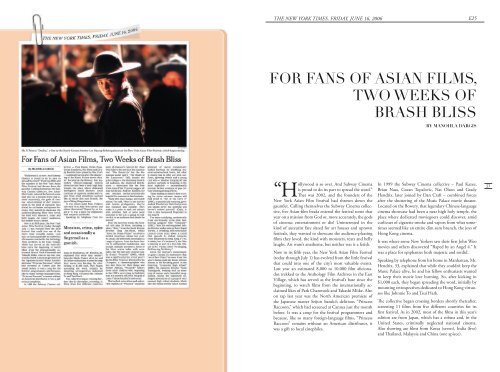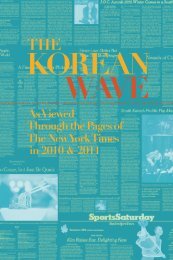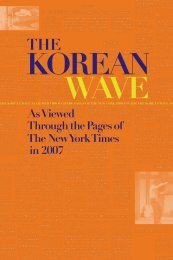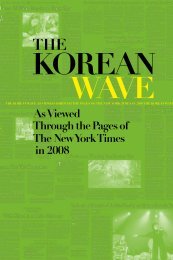The Korean Wave 2006 - Korean Cultural Service
The Korean Wave 2006 - Korean Cultural Service
The Korean Wave 2006 - Korean Cultural Service
Create successful ePaper yourself
Turn your PDF publications into a flip-book with our unique Google optimized e-Paper software.
<strong>The</strong> New York Times, friday, June 16, <strong>2006</strong><br />
e25<br />
For Fans of Asian Films,<br />
Two Weeks of<br />
Brash Bliss<br />
By MANOHLA DARGIS<br />
is so over. And Subway Cinema<br />
is proud to do its part to spread the word.”<br />
“Hollywood<br />
That was 2002, and the founders of the<br />
New York Asian Film Festival had thrown down the<br />
gauntlet. Calling themselves the Subway Cinema collective,<br />
five Asian-film freaks entered the festival scene that<br />
year on a mission from God or, more accurately, the gods<br />
of cinema: entertainment or die! Uninterested in the<br />
kind of auteurist fare slated for art houses and uptown<br />
festivals, they wanted to showcase the audience-pleasing<br />
films they loved, the kind with monsters, tears and belly<br />
laughs. Art wasn’t anathema, but neither was it a fetish.<br />
Now in its fifth year, the New York Asian Film Festival<br />
(today through July 1) has evolved from the little festival<br />
that could into one of the city’s most valuable events.<br />
Last year an estimated 8,000 to 10,000 film aficionados<br />
trekked to the Anthology Film Archives in the East<br />
Village, which has served as the festival’s base since the<br />
beginning, to watch films from the internationally acclaimed<br />
likes of Park Chanwook and Takashi Miike. Also<br />
on tap last year was the North American premiere of<br />
the Japanese master Seijun Suzuki’s delirious “Princess<br />
Raccoon,” which had screened at Cannes just the month<br />
before. It was a coup for the festival programmers and<br />
because, like so many foreign-language films, “Princess<br />
Raccoon” remains without an American distributor, it<br />
was a gift to local cinephiles.<br />
In 1999 the Subway Cinema collective – Paul Kazee,<br />
Brian Naas, Goran Topalovic, Nat Olson and Grady<br />
Hendrix, later joined by Dan Craft – combined forces<br />
after the shuttering of the Music Palace movie theater.<br />
Located on the Bowery, that legendary Chinese-language<br />
cinema showcase had been a near high holy temple, the<br />
place where dedicated moviegoers could discover, amid<br />
curlicues of cigarette smoke and vapors from what sometimes<br />
seemed like an entire dim sum brunch, the joys of<br />
Hong Kong cinema.<br />
It was where some New Yorkers saw their first John Woo<br />
movies and others discovered “Raped by an Angel 4.” It<br />
was a place for epiphanies both majestic and sordid.<br />
Speaking by telephone from his home in Manhattan, Mr.<br />
Hendrix, 33, explained that while they couldn’t keep the<br />
Music Palace alive, he and his fellow enthusiasts wanted<br />
to keep their movie love burning. So, after kicking in<br />
$1,000 each, they began spreading the word, initially by<br />
mounting retrospectives dedicated to Hong Kong virtuosos<br />
like Johnnie To and Tsui Hark.<br />
<strong>The</strong> collective began crossing borders shortly thereafter,<br />
screening 11 films from five different countries for its<br />
first festival. As in 2002, most of the films in this year’s<br />
edition are from Japan, which has a robust and, in the<br />
United States, criminally neglected national cinema.<br />
Also showing are films from Korea (seven), India (five)<br />
and Thailand, Malaysia and China (one apiece).<br />
27





